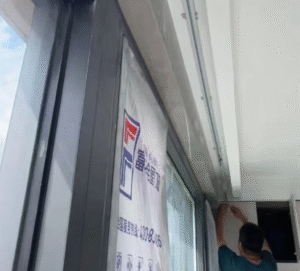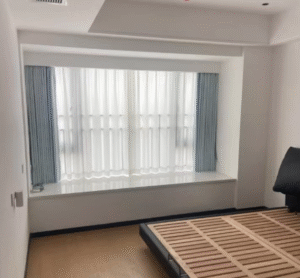You’re trying to build a profitable business selling curtain hardware, but it feels like a race to the bottom. Every competitor is focused on one thing: the price per foot of track. This constant pressure on margins squeezes your profits and makes it hard to grow. But what if the real money isn't in the hardware at all? The secret is to stop selling products and start selling solutions. By owning the complexity your clients want to avoid, you can unlock a world of high-margin services.
Intermediaries can profit significantly from white-label curtain track deals by shifting their focus from hardware margins to service-based revenue. The most successful partners don't just resell tracks; they bundle the product with high-value services. This includes project management for complex installations, specialized technical support for motorization and smart home integration, and offering a complete, stress-free solution. The track becomes the key that unlocks a lucrative ecosystem of project fees, consultation charges, and installation contracts that clients gladly pay for.
When I first started in this business, working on the factory floor, I saw where the value was created. It wasn't just in making a perfect track. It was in how that track solved a problem for someone. I remember a hotel project with huge, curved windows. The architect was struggling to find a solution. We didn't just sell them track; we helped design a custom-curved system and worked with their installers to get it right. They didn't just pay for the metal; they paid for our expertise that solved their multi-million dollar headache. This is the core insight my most successful partners understand. They see our white-label tracks not as the final product, but as the starting point for their own high-value offerings.
What are the most effective margin models for intermediaries in white-label partnerships?
You’ve found a great white-label curtain track supplier, but you're stuck on pricing. If you use a simple cost-plus model, your margins are thin and you’re always vulnerable to a competitor undercutting you by a few cents. This makes it impossible to build a stable, profitable business. You feel like you're just a middleman, not a valuable partner. You need a model that reflects the true value you provide, beyond just the hardware itself.
The most effective margin model for intermediaries is a blended approach. This model combines a modest, competitive margin on the white-label hardware with significant, high-margin fees for value-added services. Instead of just adding 20% to the track cost, you sell the hardware closer to cost and charge separately for project management, system design, technical integration, and specialized installation. This makes your hardware price attractive while your overall project profit comes from the services your competitors can't offer.
Focusing only on the hardware cost is a trap. The real profit is in solving problems. When you shift your pricing model to reflect this, you change the conversation with your client. You're no longer just a reseller haggling over pennies. You're a solutions provider who manages complexity, and that expertise is worth a premium. Let's look at how these models work in practice.
Cost-Plus Pricing: The Basic Model
This is the simplest model. You take the cost of the hardware from the manufacturer and add a fixed percentage markup. It’s easy to calculate, but it’s also the least profitable and most competitive model. It puts all the focus on the product price, making it a race to the bottom. This model works for high-volume, low-service sales, but it doesn't build a strong brand or customer loyalty.
Value-Based Pricing: The Expert Model
Here, your price is based on the value you deliver to the client, not your own cost. For example, if you are providing a motorized solution for a luxury home that integrates with their existing Control4 system, you are not just selling a motor and a track. You are selling convenience, luxury, and a seamless smart home experience. The price should reflect this high value, and the hardware cost becomes a small part of the total project fee.
Blended Margin: The Strategic Model
This is the most strategic and sustainable approach. You use a low margin on the physical track to win the business. This makes your bid highly competitive on the component that everyone compares. Then, you price your services—like custom bending for a curved window, coordinating with electricians for a motorized system, or managing the entire installation schedule—at a much higher margin. This approach gives you the best of both worlds: a competitive entry point and high overall profitability.
| Margin Model | How It Works | Best For | Profit Potential |
|---|---|---|---|
| Cost-Plus | Add a fixed % markup to the hardware cost. | High-volume, simple transactions. | Low |
| Value-Based | Price based on the solution's value to the client. | Complex, high-stakes projects. | High |
| Blended Margin | Low margin on hardware, high margin on services. | Most B2B and project-based sales. | Very High |
Which operational risks do intermediaries face with white-label tracks?
You've decided to launch your own brand of curtain tracks using a white-label partner. It seems simple: buy from a manufacturer, put your logo on it, and sell. But soon, you're facing unexpected problems. A shipment is delayed, holding up a major project. A batch of carriers has a slight color variation, damaging your brand's reputation for quality. You are spending all your time putting out fires instead of growing your business, realizing the operational side is far more complex than you imagined.
Intermediaries in white-label deals face significant operational risks, primarily in logistics, quality control, and brand management. The biggest risks include supply chain disruptions delaying projects, inconsistent product quality from the manufacturer damaging your brand's reputation, and holding large amounts of inventory that ties up cash. Effectively managing these risks requires a strong partnership with your manufacturer and robust internal processes for inspection and inventory management. Otherwise, the dream of an easy business can quickly become a logistical nightmare.
From my position as a manufacturer, I can tell you that we have comprehensive quality control systems inside our factory. But the moment the product leaves our doors, our control ends. This is where a strong intermediary partner becomes so important. The most successful ones don't just trust; they verify. They have their own processes to manage the risks that come with building a brand. They understand that their name is on the box, so the final responsibility for quality rests with them.
Supply Chain and Logistics
When you are the brand, your client doesn't care if a shipping container is stuck at a port. They only know that their project is delayed because of you. You are taking on the risk of global supply chains. This includes manufacturing lead times, shipping delays, and customs clearance. The key to managing this is clear communication with your supplier and maintaining a buffer of safety stock for your most popular items.
Quality Control and Consistency
"Quality fade" is a real risk. A supplier might provide a perfect sample, but over time, the quality of production batches can slip. Maybe the aluminum alloy changes slightly, or the finish on the brackets isn't quite the same. As the brand owner, you must have your own quality assurance process. This could be as simple as inspecting a percentage of every shipment before it goes to your clients. Your brand's reputation depends on this consistency.
Inventory and Cash Flow
Holding inventory costs money. You need warehouse space, insurance, and staff. More importantly, the money you spent on products sitting on a shelf is cash you can't use to market your business or fund other operations. Overstocking unpopular items can be a huge drain. A good white-label strategy involves working closely with your manufacturer to understand lead times, allowing you to use a just-in-time inventory model where possible.
| Operational Risk | Mitigation Strategy | Why It Matters |
|---|---|---|
| Supply Chain Delays | Regular communication with supplier; hold safety stock. | Protects project timelines and client relationships. |
| Inconsistent Quality | Implement your own incoming goods inspection process. | Protects your brand's reputation for quality. |
| Inventory Costs | Use sales data to forecast demand; explore drop-shipping. | Frees up cash flow and reduces overhead. |
| Branding Errors | Provide clear branding guidelines; approve an FAI (first article inspection) | Ensures brand consistency on all packaging and products. |
How can intermediaries build value and justify higher fees?
You're trying to sell your white-label curtain track system, but the client keeps pushing back on your price. "I can get a similar track online for less," they say. They see you as just another reseller, a middleman adding a markup. It’s frustrating because you know you offer more, but you are struggling to communicate that value. You need to shift the client's focus from the hardware to the complete solution you provide.
Intermediaries can justify higher fees by becoming indispensable problem-solvers. Instead of just delivering a box of parts, you should manage the entire process. This means offering technical consulting during the design phase, managing the logistics to ensure on-time delivery, coordinating with other trades like electricians and painters, and providing after-sale support. When the client sees you as the expert who makes their complex project simple, they are no longer buying a track; they are buying peace of mind, which is worth a significant premium.
Over the years, I've seen two types of partners. The first type sends us a purchase order for 500 meters of track. The second type calls us to discuss their client's project. They ask about load capacity for a heavy velour drape, or the best motor to integrate with a Lutron system. Guess which partner is more profitable? It’s the second one. They use our technical knowledge to build their own expertise, which they then sell to their client at a high margin. They wrap our product in a layer of valuable service.
Become a Technical Consultant
Don't just be a salesperson; be an expert. Learn the technical specifications of your products inside and out. Understand which track is best for heavy-duty use, which carriers are quietest, and how to motorize a curved window. When an architect or designer comes to you with a challenge, you can provide a real solution. This consultative approach immediately elevates you above a simple reseller.
Own the Project Management
A construction or renovation project has many moving parts. The curtain track installation needs to be coordinated with painters, electricians, and floor installers. Offer to take on this coordination. By managing the timeline and communicating with all the other trades, you are removing a huge headache for your client. This project management service is a highly valuable, chargeable line item.
Provide Post-Sale Support and Guarantees
Your relationship with the client shouldn't end when the invoice is paid. Offer a warranty on the installation and be available for any adjustments or questions after the project is complete. This shows that you stand behind your work and your product. This long-term reliability is something clients are willing to pay for, and it builds the trust that leads to repeat business and referrals.
| Role | Reseller Action | Solutions Provider Action |
|---|---|---|
| Sales Process | Sends a quote for hardware. | Conducts a needs analysis meeting. |
| Expertise | Knows product part numbers. | Understands technical applications. |
| Service | Arranges shipping. | Manages the project timeline and installation. |
| Client View | A supplier to be negotiated down. | A valuable partner to solve problems. |
What marketing strategies attract end-users to a white-label brand?
You've created a fantastic white-label brand for your curtain tracks. The quality is excellent, and your service is top-notch. The problem is, nobody has ever heard of you. You are competing against established industry names, and your marketing budget is limited. Simply running ads showcasing your product isn't working because you have no brand recognition. You need a smarter way to attract customers and build trust from the ground up.
The most effective marketing strategy for a new white-label brand is to stop marketing the product and start marketing your solutions. Instead of showing pictures of your track, create case studies of challenging projects you've completed. Gather testimonials from satisfied architects and installers. Write blog posts that answer the technical questions your clients are asking. By positioning your brand as a helpful expert and a problem-solver, you build trust and attract high-quality leads who are looking for expertise, not just a low price.
When we work with new partners to develop their white-label brand, the first thing I tell them is this: your brand story is not about the track. It's about what your clients can achieve with the track. It’s the story of the boutique hotel that now has perfectly silent, motorized drapes. It’s the story of the homeowner with a curved wall of glass who finally found a curtain solution that looks beautiful. Your marketing should tell these stories. Your future customers will see themselves in these stories and will want that same success for their own projects.
Content Marketing for Experts
Create content that demonstrates your expertise. This could be a blog, a series of short videos, or a downloadable guide. Focus on answering the common questions and solving the common problems your target audience faces. Topics like "How to Specify a Curtain Track for a Curved Wall" or "3 Things to Know Before Motorizing Your Drapes" will attract professionals looking for answers, positioning you as an authority.
Target the Specifiers
While the end-user might be a homeowner or a hotel, the key decision-maker is often an architect, interior designer, or professional installer. Focus your marketing efforts on them. Join their professional organizations, attend their trade shows, and create content specifically for them. A single designer who trusts your brand can bring you dozens of projects over the years.
Build a Portfolio of Success
Your best marketing tool is your completed work. Take high-quality photos and videos1 of every significant project. Write up a short case study2 explaining the client's problem, your solution, and the final result. A portfolio of beautiful, successful installations is more persuasive than any advertisement. It is tangible proof that you deliver on your promises.
| Marketing Tactic | Product-Focused Approach (Less Effective) | Solution-Focused Approach (More Effective) |
|---|---|---|
| Website | Features product catalogs and price lists. | Features case studies and a project portfolio. |
| Social Media | Posts pictures of the hardware. | Shares testimonials from happy clients. |
| Blog Content | "Our New Track Is Stronger" | "How to Choose the Right Track for Heavy Drapes" |
| Sales Pitch | "Our tracks are the best price." | "We can manage your entire window treatment project." |
Conclusion
Ultimately, the path to profiting from a white-label curtain track business is to lift your vision beyond the hardware. As I learned early on, the track itself is just a component. The real, sustainable profit lies in the expertise and service you wrap around it. By becoming a project manager, a technical expert, and a trusted consultant, you solve the complex problems that clients are more than willing to pay a premium for. You stop competing on the cost per foot and start winning business based on the value you create. This is how you build not just a profitable business, but a respected brand.








